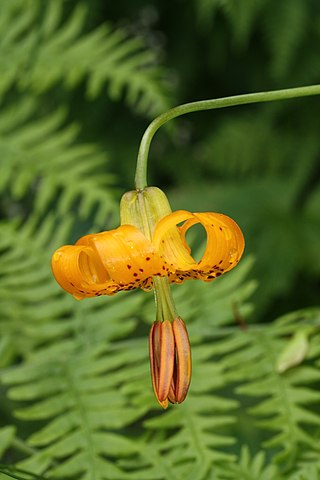Top Qs
Timeline
Chat
Perspective
Lilium columbianum
Species of lily From Wikipedia, the free encyclopedia
Remove ads
Lilium columbianum is a lily native to western North America.[2][3] It is also known as the Columbia lily, Columbia tiger lily, or simply tiger lily (sharing the latter common name with several other lily species in its genus).
Remove ads
Distribution and habitat
Lilium columbianum occurs in lowland and montane forest openings and meadows from southern British Columbia in Canada south to northern California and east to Montana in the northwestern United States.[2][4] Mostly occurring below 2,000 m (6,600 ft), it usually blooms in June through early August.[2] There are a few isolated populations at high elevations in the Sierra Nevada as far south as Fresno County.[5][6]
Remove ads
Description
Lilium columbianum is a perennial herb[7] that grows up to 1.2 metres (3.9 ft) tall, and bears from few to numerous orange flowers with darker spots. The tepals are 3 to 6 cm long and the flowers are lightly scented. Like many true lilies, the leaves are arranged in whorls around the stem of the plant.[8][9][10][5][11]
Uses
Food
Coast Salish, Nuu-chah-nulth and most western Washington peoples steamed, boiled or pit-cooked its bulbs. Bitter or peppery-tasting, they were mostly used as a flavoring, often in soup with meat or fish.[12]
Horticulture
From seed, Lilium columbianum requires three to five years to mature. Cultivated bulbs can be divided or bulb scales may be used to generate new plants more quickly.[13]
Gallery
- Lilium columbianum flower, from a garden in Scotland.
- Columbia Lily Buds
- Lilium columbianum by creek
- Lilium columbianum anthers
- Lilium columbianum in burned area
- The fruit is an erect capsule that is generally smooth and contains numerous flat seeds in six stacks.
- Lilium columbianum bud & flowers, at 7000 ft in Sierra Nevada
References
External links
Wikiwand - on
Seamless Wikipedia browsing. On steroids.
Remove ads









